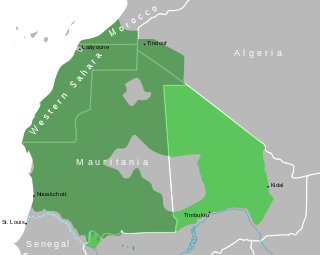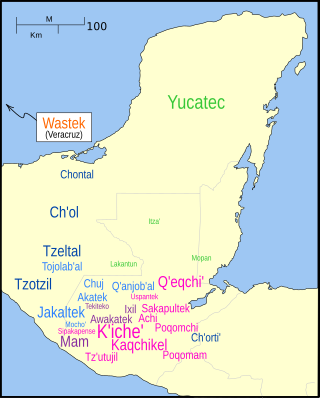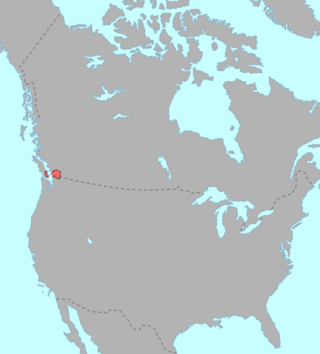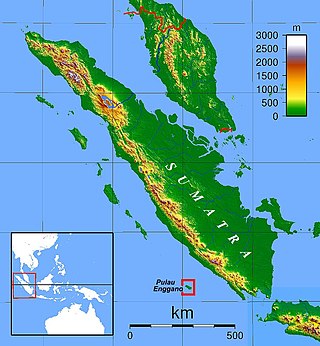Related Research Articles

The Bangka Belitung Islands is a province of Indonesia. Situated off the southeastern coast of Sumatra, the province comprises two main land masses — Bangka and Belitung — and numerous smaller islands. Bangka Belitung is bordered by the Bangka Strait to the west, the Natuna Sea to the north, the Java Sea is to the south and the Karimata Strait to the east. The province's capital and largest city is Pangkalpinang. The province shares maritime borders with South Sumatra to the west, Riau Islands to the north, Banten, the Special Capital Region of Jakarta, West Java, and Central Java to the south, and West Kalimantan to the east. Bangka Belitung covers a land area of 16,690.54 km2 (6,444.25 sq mi) and had a population of 1,455,678 according to the 2020 census; the official estimate as at mid 2022 was 1,494,621.

Hassaniya Arabic is a variety of Maghrebi Arabic spoken by Mauritanian Arabs and the Sahrawi people. It was spoken by the Beni Ḥassān Bedouin tribes of Yemeni origin who extended their authority over most of Mauritania and Morocco's southeastern and Western Sahara between the 15th and 17th centuries. Hassaniya Arabic was the language spoken in the pre-modern region around Chinguetti.
Manado Malay, or simply the Manado language, is a creole language spoken in Manado, the capital of North Sulawesi province in Indonesia, and the surrounding area. The local name of the language is bahasa Manado, and the name Minahasa Malay is also used, after the main ethnic group speaking the language. Since Manado Malay is used primarily for spoken communication, there is no standard orthography.

Tzeltal or Tseltal is a Mayan language spoken in the Mexican state of Chiapas, mostly in the municipalities of Ocosingo, Altamirano, Huixtán, Tenejapa, Yajalón, Chanal, Sitalá, Amatenango del Valle, Socoltenango, Las Rosas, Chilón, San Juan Cancuc, San Cristóbal de las Casas and Oxchuc. Tzeltal is one of many Mayan languages spoken near this eastern region of Chiapas, including Tzotzil, Chʼol, and Tojolabʼal, among others. There is also a small Tzeltal diaspora in other parts of Mexico and the United States, primarily as a result of unfavorable economic conditions in Chiapas.

Halkomelem is a language of various First Nations peoples of the British Columbia Coast. It is spoken in what is now British Columbia, ranging from southeastern Vancouver Island from the west shore of Saanich Inlet northward beyond Gabriola Island and Nanaimo to Nanoose Bay and including the Lower Mainland from the Fraser River Delta upriver to Harrison Lake and the lower boundary of the Fraser Canyon.

Southern Sierra Miwok is a Utian language spoken by the Native American people called the Southern Sierra Miwok of Northern California. Southern Sierra Miwok is a member of the Miwok language family. The Miwok languages are a part of the larger Utian family. The original territory of the Southern Sierra Miwok people is similar to modern day Mariposa County, California. The Southern Sierra Miwok language is nearly extinct with only a few speakers existing today. However, as of 2012, an active revitalization program is underway.

The Tarahumara language is a Mexican Indigenous language of the Uto-Aztecan language family spoken by around 70,000 Tarahumara (Rarámuri/Ralámuli) people in the state of Chihuahua, according to a 2002 census conducted by the government of Mexico.

Tiipai (Tipay) is a Native American language belonging to the Delta–California branch of the Yuman language family, which spans Arizona, California, and Baja California. As part of the Yuman family, Tiipai has also been consistently included in the controversial quasi-stock Hokan. Tiipai is spoken by a number of Kumeyaay tribes in northern Baja California and southern San Diego County, California. There were, conservatively, 200 Tiipai speakers in the early 1990s; the number of speakers has since declined steadily, numbering roughly 100 speakers in Baja California in a 2007 survey.
Misantla Totonac, also known as Yecuatla Totonac and Southeastern Totonac, is an indigenous language of Mexico, spoken in central Veracruz in the area between Xalapa and Misantla. It belongs to the Totonacan family and is the southernmost variety of Totonac. Misantla Totonac is highly endangered, with fewer than 133 speakers, most of whom are elderly. The language has largely been replaced by Spanish.

The Nukak language is a language of uncertain classification, perhaps part of the macrofamily Puinave-Maku. It is very closely related to Kakwa.
Garre is an Afro-Asiatic language spoken by the Garre people inhabiting southern Somalia, Ethiopia and northern Kenya. It belongs to the family's Cushitic branch, and had an estimated 50,000 speakers in Somalia in 1992, 57,500 in 2006 and 83,600 in 2019. The total number of speakers in Kenya and Somalia was estimated at 685,600 in 2019. Garre is in the Digil classification of Somali dialects. Garre language is readily intelligible to Digil speakers, as it has some affinity with Af-Maay and Af-Boon.
Lau (Law) is a Jukunoid language of Lau LGA, Taraba State, Nigeria. Lau speakers claim that their language is mutually intelligible with the Jukunoid language varieties spoken in Kunini, Bandawa, and Jeshi. They also live alongside the Central Sudanic-speaking Laka, who live in Laka ward of Lau LGA.
Leti is an Austronesian language spoken on the island of Leti in Maluku. Although it shares much vocabulary with the neighboring Luang language, it is marginally mutually intelligible.

The Enggano language, or Engganese, is an Austronesian language spoken on Enggano Island off the southwestern coast of Sumatra, Indonesia.
This article explains the phonology of Malay and Indonesian based on the pronunciation of Standard Malay, which is the official language of Brunei, Singapore and Malaysia, and Indonesian, which is the official language of Indonesia and a working language in Timor Leste. There are two main standards for Malay pronunciation, the Johor-Riau standard, used in Brunei and Malaysia, and the Baku, used in Indonesia and Singapore.
Muna is an Austronesian language spoken principally on the island of Muna as well as North-west Buton Island, off the southeast coast of Sulawesi in Indonesia. the island of Tobea Besar. The language is well-documented, especially by linguist René van den Berg. In 2010, the language had around 270,000 speakers.
Malay grammar is the body of rules that describe the structure of expressions in the Malay language and Indonesian. This includes the structure of words, phrases, clauses and sentences. In Malay and Indonesian, there are four basic parts of speech: nouns, verbs, adjectives, and grammatical function words (particles). Nouns and verbs may be basic roots, but frequently they are derived from other words by means of prefixes and suffixes.
The Republican Spelling System or Soewandi Spelling was the orthography used for Indonesian from 17 March 1947 until 1972.
Amarasi is a Central Malayo-Polynesian language of West Timor, and is spoken by the Amarasi. The Amarasi language has about 80,000 native speakers, with four main dialects called Ro'is, Kotos, Tais Nonof, and Ketun, though many differences exist between individual villages. It uses Subject-Object-Verb grammar structure. Speakers are interspersed with those of Helong.
Ambonese Malay or simply Ambonese is a Malay-based creole language spoken on Ambon Island in the Maluku Islands of Eastern Indonesia. It was first brought by traders from Western Indonesia, then developed when the Dutch Empire colonised the Maluku Islands and was used as a tool by missionaries in Eastern Indonesia. Malay has been taught in schools and churches in Ambon, and because of this it has become a lingua franca in Ambon and its surroundings.
References
Citations
- 1 2 Bangka Malay at Ethnologue (18th ed., 2015) (subscription required)
- ↑ "Indonesiatraveling.com". Archived from the original on 2011-02-22. Retrieved 2010-09-14.
- 1 2 3 4 5 6 Miyake, Sarman & Fithrorozi 2022, p. 4.
- 1 2 3 Miyake, Sarman & Fithrorozi 2022, p. 3.
- ↑ Miyake, Sarman & Fithrorozi 2022, pp. 4–5.
- ↑ Miyake, Sarman & Fithrorozi 2022, p. 5.
Bibliography
- Miyake, Yoshimi; Sarman, Hendry; Fithrorozi (31 March 2022). "A preliminary study of Belitung Malay". NUSA: Linguistic studies of languages in and around Indonesia. 72: 17. Retrieved 2 January 2024– via TUFS Prometheus Academic Collections.